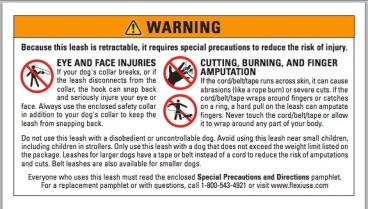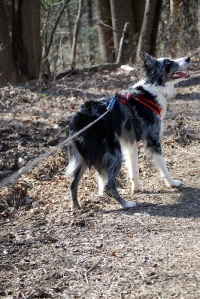Ah, the ever-popular retractable leash, also commonly known as a Flexi leash. They seem like a great idea on paper– a plastic handle with a leash rolled up inside, giving your dog 15 feet of freedom to explore his world. A thumb on the button will lock the leash at the current length, but unlocked, the length of the leash is dictated by the dog.
Unfortunately, in the real world, the retractable leash isn’t always the best idea.
First and foremost is the concern for human safety.
Have you ever looked at the special precautions and safety information attached to one of these leashes? Extensive and downright frightening! It is definitely user beware! Cuts, burns, facial injuries, even finger amputations!
According to Consumer Reports, in 2007 there were 16,564 hospital-treated injuries to humans that were associated with leashes. While the report did not differentiate between Flexi and non-Flexi injuries, it did state that “[t]he most common injuries reported were burns and cuts, usually sustained when the cord came in contact with skin as it rapidly paid out from the handle of a leash.” As no other leashes have cords that pay out from a handle, these have to be retractable-leash related injuries. (Do a quick Google images search for “Flexi Leash injury” if you’re feeling brave– there is some awful looking stuff out there!)
Unfortunately, far too often it is not the user of the leash who gets injured. Far too often, innocent bystanders are literally caught up in the leash and injured either by the cord itself or by the handle flying toward them when the dog-owner loses his grip. This is especially scary when you think of how easily a child could get caught up in one of these leashes, and how soft their skin is.
Secondly, there is the concern for the safety of dogs.
There is no shortage of stories about dogs getting into trouble while on retractable leashes. Dogs are hit by cars when they bolt after something and the owner doesn’t have the reflexes to lock the leash (or the locking mechanism fails) before the dog runs out into the street. Dog bites and fights are always a possibility when dogs are not really under the control of their owner fifteen feet behind them. Not all dogs appreciate a strange dog rushing up to them, and a dog coming around the corner far ahead of his owner can lead right into a dangerous situation. There is also the risk of damage to a dog’s neck and throat if he hits the end of the leash at a high rate of speed and is stopped dead by the collar around his throat. Ouch.
You also run the very real risk of a dog getting away from you and getting scared by the big plastic handle “chasing” them, causing them to run in fear and get lost or hit by a car or some other awful scenario. Dogs can also be hurt by the flying plastic handle recoiling toward them.
Most of these scenarios can be avoided by using care and paying attention to your dog, and by only using a retractable leash in appropriate environments.
Flexi leashes really are not appropriate for any place where you are near traffic or large numbers of people or dogs. This includes petstores and veterinary hospitals! The other patients waiting in a veterinary waiting room are likely stressed and not feeling at the top of their game. This combined with an unwelcome greeting from a friendly dog on a long leash can result in even more stress for a sick pet, as well as a dangerous situation. If you must use a retractable leash in these situations, it should be locked at a short length at all times. And keep your thumb off the button of temptation! In public, a traditional four to six foot leash is really a much better choice for keeping your dog safe, as well as keeping the dogs and people around you safe.
Retractable leashes can be a great tool in certain circumstances, however. For example, letting your pooch out to potty in an unfenced area, whether your own backyard or at a reststop or hotel while traveling. They are also a way to give well-mannered dogs the opportunity to explore and be dogs in open, secluded areas. They can be great for hiking on trails that are not heavily traveled. They can be great out in the gamelands when you need to keep your dog with you, but there’s nobody around that he is going to bother.
It’s always best to use a retractable leash with a harness in case your dog does take off on you. That way he does not risk damage to his throat or neck. It also differentiates for him when it is ok to pull (to extend the flexi) vs when it is not (on a regular leash attached to his collar).
Used thoughtfully, retractable leashes can indeed provide a benefit to dog and handler, but it is important to be aware of the risks and to always be careful and attentive about your environment and the impact your dog may be having on others with his Flexi freedom.

